This Insane Rocket Is Why The Soviet Union Never Made It To The Moon
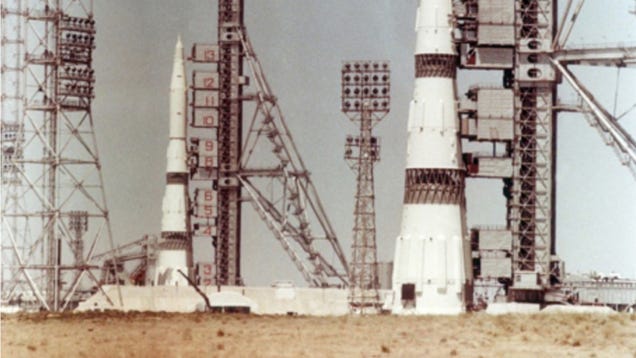
Americans
tend to talk a lot about the Space Race and how we made it to the Moon
and we were first and no one else was second because we are the best.
It's put into context by the fact that the Soviet satellite Sputnik was
the first in space, but by the time we get around to discussing the moon
landings no one mentions why. And this enormous, absolutely insane
rocket is the reason.
Sure, one
could go in and argue that the failure of the Soviet Union to make it to
the Moon was a result of an incompatible governing system, or economic
hurdles, or a myriad of other factors contributed to the communist
nation never placing a human on the lunar surface, but they all
culminated in this, the N1 rocket.
If you were
an alien observing earth sometime around January 1962 you may be
forgiven for placing a bet on the Soviet Union as the eventual winner of
the Space Race. They had gotten the first satellite into space, the
first animal into space, and not only the first human into space with
cosmonaut Yuri Gagarin, but they also had him orbit the Earth. Americans
had managed to come in second every time, and the only manned
spaceflight they accomplished was a simple suborbital flight. And in
case you're not sure what that means, it means that they had astronaut
Alan Shepard shoot straight up and straight down, and that was it.
He was in flight for less than half an hour.
The Space
Race effectively ended with the landing of the Apollo 11 mission on the
Moon in July of 1969. Where were the Soviets though? Shouldn't they have
been the ones saying "медведь приземлился" on the powdery gray
landscape?
The N1
rocket that they created to take them there was almost as big as the
Saturn V that took Neil Armstrong, Buzz Aldrin, and Michael Collins to
the Moon. It was a bit shorter, and a bit lighter, but it had more
thrust out of the gate. How it got that massive boost was probably its
downfall.
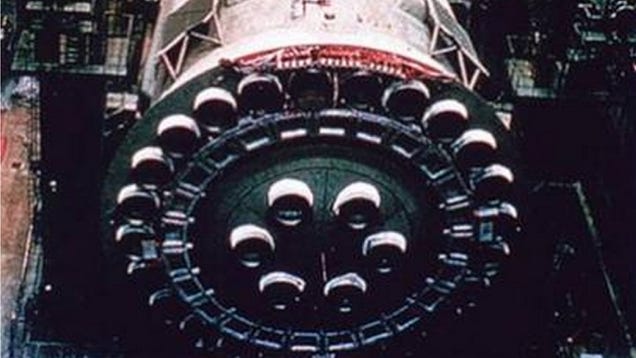
As you can
see from the picture above, the N1 had a lot of engines. Whereas the
Saturn V was powered by only five enormous engines, the N1 had thirty
little ones. 24 of them formed a ring around the outside of Block A, the
name for the first stage, with six placed in the center to provide roll
control. The thinking was that if one of these small little engines was
good, then strapping them all together would be great. This idea went
horribly wrong though.
Think about it this way. The Saturn V, with its comparatively simple system, still had over six million
different parts. If only .1% of those parts broke during the
horrifically violent event that is a rocket launch, over six thousand
would still break leading to (hopefully) instantaneous fiery death. Not
good.
And yet the Saturn V itself never resulted in a fatality. (The Apollo 1 astronauts
were tragically killed, but that was due to a failure in the command
capsule oxygen system). The Soviet system was infamous for poor quality
work, and when you get thirty engines in one single stage, place them
all right next to each other, and light the match, a failure of one
would lead to an extremely fast domino effect, which would lead to a massive explosion.
Which is exactly what happened.
One Little Bolt
Of the four N1 test launches, all of them failed. None so spectacularly, though, as the second launch attempt.
The N1
seemed to adhere to the rule of "what goes up, most come down" more than
any other in Newtonian physics, and shortly after lifting off from the
launch pad it came right back down, crashing to earth and combusting.
It turns
out a bolt had come loose and was sucked straight into an oxygen pump
fueling one of the thirty little engines, which then promptly exploded,
setting off a chain reaction.
The rocket
exploded with the force of seven kilotons of TNT, equivalent to a small
nuclear bomb. It remains one of the largest non-nuclear explosions in
human history. The destruction was so vast, in fact, that it let the
Americans know what the Soviet Union was up to when satellites
photographed the wrecked launch pad. It took 18 months for the USSR to
rebuild it. This time, they installed fuel filters.
Oh, and the entire thing was fueled by kerosene. It's not quite a lamp, this thing.
Pogo Pogo Pogo
The fourth
and final unsuccessful N1 launch, in 1972, also resulted in a massive
explosion, this time from a phenomenon known as pogo oscillation.
Pogo oscillation is exactly what it sounds like – a violent up-and-down
motion that could make anybody sick, but makes rockets really really
sick. It results from a variation in thrust from different engines, and
with thirty unreliable ones, you can get a lot of variation. Once it
starts, it's very hard to correct, as the variable acceleration leads to
variable fuel pump pressures, which leads to more variables
acceleration, and so on and so on until eventually you match the
vehicle's resonance frequency and vibrate the whole thing to death.
Protip: Name your next band "Pogo Of Death," the kids will love you.
This time,
the N1 managed to get up to 40 kilometers in altitude before it
encountered the dreaded pogo oscillation. An orderly shutdown of the
engines was begun, which sounds easy enough. Of course, because this was
the Soviet Union and the N1, it didn't exactly go according to plan.
Instead of shutting down, one of the liquid oxygen pumps of course
exploded.
Another enormous boom resulted.
With that, the Soviet Union decided to pack it in on its plans to put a person on the moon.
Although
the US found out about the whole program due to satellite overflights,
it was officially denied by the USSR until 1989 as it was thought to be
such a huge embarrassment. By then, it would only be two years until the
Union of Soviet Socialist Republics would disintegrate itself.
From Wikipedia, the free encyclopedia
(Redirected from Soviet Moonshot)
Main article: Soviet space program
Contents
Early concepts
Another main space design bureau headed by Vladimir Chelomei proposed a competing cislunar orbiting mission using a heavy UR-500K rocket (later renamed the Proton rocket) and a two-man LK-1 spacecraft. Later, Chelomei also proposed a Moon landing program with a super-heavy UR-700 rocket and a LK-700(LK-3) spacecraft.
The Soviet government issued a response to the American Apollo challenge after three years. According to the first government decree about the Soviet Manned moon programs (' On Work on the Exploration of the Moon and Mastery of Space '), adopted in August 1964, Chelomei was instructed to develop a Moon flyby program with a projected first flight by the end of 1966, and Korolyov was instructed to develop the Moon landing program with a first flight by the end of 1967.
Following the change from Nikita Khrushchev to Leonid Brezhnev in 1964, the Soviet government in September 1965 assigned the flyby program to Korolyov, who redesigned the cislunar mission to use his own L1 (Zond) spacecraft and Chelomei's Proton rocket.
Korolyov organized full scale development of both programs, but died after surgery in 1966. According to a government decree of February 1967, the first manned flyby was scheduled for mid-1967, and the first manned landing for the end of 1968. Korolyov's death, along with various technical and administrative reasons, as well as a lack of financial support, resulted in both programs being delayed.
Launch schedules
As of 1967, the L1/L3 launch schedules were:L1
- 2P: Develop Block D stage (February or March 1967)
- 3P: Develop Block D stage (March 1967)
- 4L: Unmanned lunar flyby (May 1967)
- 5L: Unmanned lunar flyby (June 1967)
- 6L: Manned lunar flyby (June or July 1967)
- 7L: Manned lunar flybys (August 1967)
- 8L: Manned lunar flybys (August 1967)
- 9L: Manned lunar flybys (September 1967)
- 10L: Manned lunar flybys (September 1967)
- 11L: Manned lunar flybys (October 1967)
- 12L: Manned lunar flybys (October 1967)
- 13L: Reserve spacecraft
- 3L: Develop LV & Blocks G&D (September 1967)
- 4L: Reserve
- 5L: LOK/LK unmanned (December 1967)
- 6L: LOK/LK unmanned (February 1968)
- 7L: Manned LOK/unmanned LK (April 1968)
- 8L: Manned LOK/unmanned LK (June 1968)
- 9L: Piloted LOK/unmanned LK with LK landing on Moon (August 1968)
- 10L: First men land on moon (September 1968)
- 11L: Reserve
- 12L: Reserve
Cosmonauts
In 1966, two cosmonaut training groups were formed. One group was commanded by Vladimir Komarov and included Yuri Gagarin, and was to prepare for qualification flights of the Soyuz in Earth orbit and a Proton-launched cis-lunar mission (Gagarin, Nikolayev, Komarov, Bykovskiy, Khrunov; Engineer-Cosmonauts: Gorbatko, Grechko, Sevastyanov, Kubasov, Volkov). Komarov later died in the Soyuz 1 spaceflight when his parachute malfunctioned causing his capsule to smash into the earth at high speed. The second group was led by Alexei Leonov and concentrated on the landing mission (Commanders: Leonov, Popovich, Belyayev, Volynov, Klimuk; Engineer-cosmonauts: Makarov, Voronov, Rukavishnikov, Artyukhin). As a result, Leonov has the strongest claim to have been the Soviets' first choice for first man on the moon.After Komarov's death in Soyuz 1 in 1967, Gagarin was taken out of training and the groups were restructured. Despite the Soyuz 1 setback, the Soviets successfully rehearsed the automated docking of two unmanned Soyuz craft in Earth orbit in 1968 and with the manned Soyuz 4 and Soyuz 5 joint mission in early 1969 tested the other key mission elements.
A total of 18 missions were related to the N1-L3 project. For details, see the table at the bottom of the article.
Moon flyby UR-500K(Proton)/L1(Zond) program
Moon landing N1/L3 program

The N1 rocket carried the L3 Moon expedition complex that consisted of two spacecraft (LOK and LK) and two (Block G and Block D) boosters.
A variant of the Soyuz craft, the "Lunniy Orbitalny Korabl" (LOK) command ship, carried two men, and consisted of three modules like the regular Soyuz 7K-OK, but was heavier by a few tons. The 7K-OK was half the mass of the three-man Apollo orbital craft (command ship). The "Lunniy Korabl" (LK) carried one cosmonaut, so in the Soviet expedition one cosmonaut alone would land on Moon, while in Apollo two would. The mass of the LK was 40% the mass the Apollo lunar lander.
The total mass of the L3 complex placed in LEO by the N1 was 93 tons compared to Saturn V's 137 tons. The total mass of the LOK and LK was 40% of the full Apollo complex, but was equivalent to the L3 complex without Block G. The booster for the LEO toward the Moon for the Apollo vehicle was provided by the last stage of the Saturn V, while for the Block D, LOK and LK, this was to be provided by Block G of the same L3 complex.
During the L3 complex's journey to the Moon, there was no need to undock and redock the orbital and landing craft as in Apollo, because the cosmonaut would transfer from the LOK to LK by a "spacewalk", while in Apollo this operation was executed by an internal passage.
Block D slowed the LOK and LK into lunar orbit, while in the Apollo complex this phase was undertaken by firing the engine on the service module (the Apollo complex traveled with the Command Module and Lunar Excursion Module (LEM) facing back towards the Earth) to slow the complex and enter lunar orbit.
Once in orbit, the LK with Block D would separate from the LOK and descend toward the surface of Moon using the Block D engine. After Block D exhausted its fuel, the LK was to separate and complete landing using its own engine.
On the Moon, the cosmonaut would undertake moonwalks on foot and by Lunokhods, collect rocks, and plant the Soviet flag.
After a few hours on the lunar surface, the LK's engine would fire again using its landing structure as a launch pad, as with Apollo. To save weight, the engine used for landing would also blast the LK back to lunar orbit for an automated docking with the LOK. The cosmonaut then would spacewalk back to the LOK carrying the Moon rock samples, with the LK being cast off. After this, the LOK would fire its rocket for the return to Earth.
After the US won the final (Moon-landing) phase and the whole of the Moon Race in 1969, the justification for the Soviet lunar landing program evaporated, although development and testing continued into the early 1970s. In 1970–1971 the LK was completely ready after three unmanned test flights on LEO (Kosmos 379, Kosmos 398, Kosmos 434), and the LOK was launched once (Kosmos 382 aka 7K-L1E dummy of 7K-LOK). The Krechet lunar spacesuit and other support systems were tested.
Four N1 test launches were attempted in 1969, 1971, and 1972 and all were failures, despite engineering improvements after each crash. The second launch attempt on 3 July 1969, just 13 days prior to the launch of Apollo 11, was a catastrophic failure which destroyed both the rocket and the launch complex, and this delayed the N1-L3 program for two years more. For automatic Moon flyby, at these two first launches the N1 carried the 7K-L1S spacecraft (modified 7K-L1), while dummy 7K-LOK (7K-L1E) and regular 7K-LOK with dummy LKs at both were at third and fourth launches.
Subsequently, the complete L3 lunar expedition complex with regular 7K-LOK and regular LK for Moon flyby and landing by full unmanned mission of future manned scenario was prepared for fifth launch of modified N1 rocket on August, 1974. If this and one subsequent mission had been successful, up to five Soviet manned N1-L3 expeditions would have been launched in 1976–1980.
But N1-L3 (as well as N1F-L3M) program was cancelled on May, 1974, and Soviet manned space efforts subsequently concentrated on the development of space stations and on several design and ground preparatory processes for a Mars mission, which continues to the present day, but has unclear objectives.[1]
Laterly proposed moonbase Zvezda, first detailed such project with developed mockups of expedition vehicles[2] and surface modules,[3] and "Vulkan-LEK" project were not adopted for economic reasons. As some recompense and as a replacement for the manned landing program, the Soviets fulfilled a program of automated delivery of lunar soil and Lunokhods automated moon rovers.
The launch pad and MIK of N1 was redesigned for the Energia-Buran shuttle program. At least five LKs and three LOKs in various states of construction remain with some units being kept in the designer's and producer's company museums. Near 150 engines produced for first stages of N1F were kept by manufacturer (Kuznetsov Design Bureau) and sold for use on US launchers around the year 2000.
Gallery
-
LK Lander - Lunniy Korabl ascent from Moon
-
Apollo CSM and LOK (Soyuz 7K-L3) (drawn to scale). Command ships for the Moon voyage

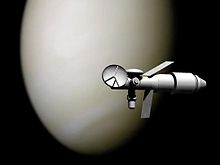
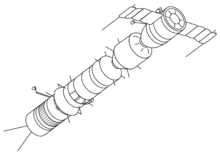

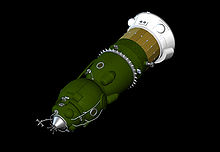





No comments:
Post a Comment